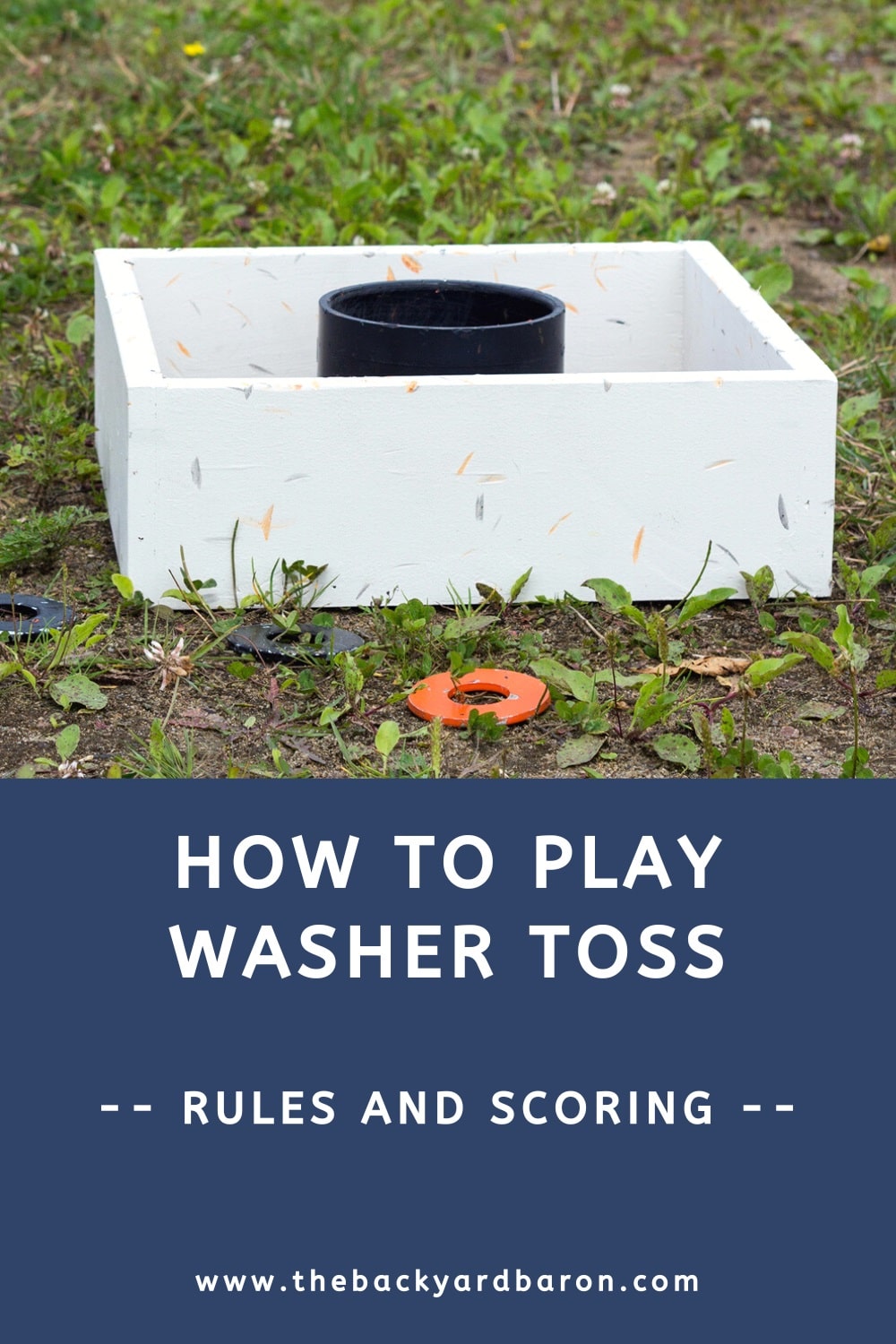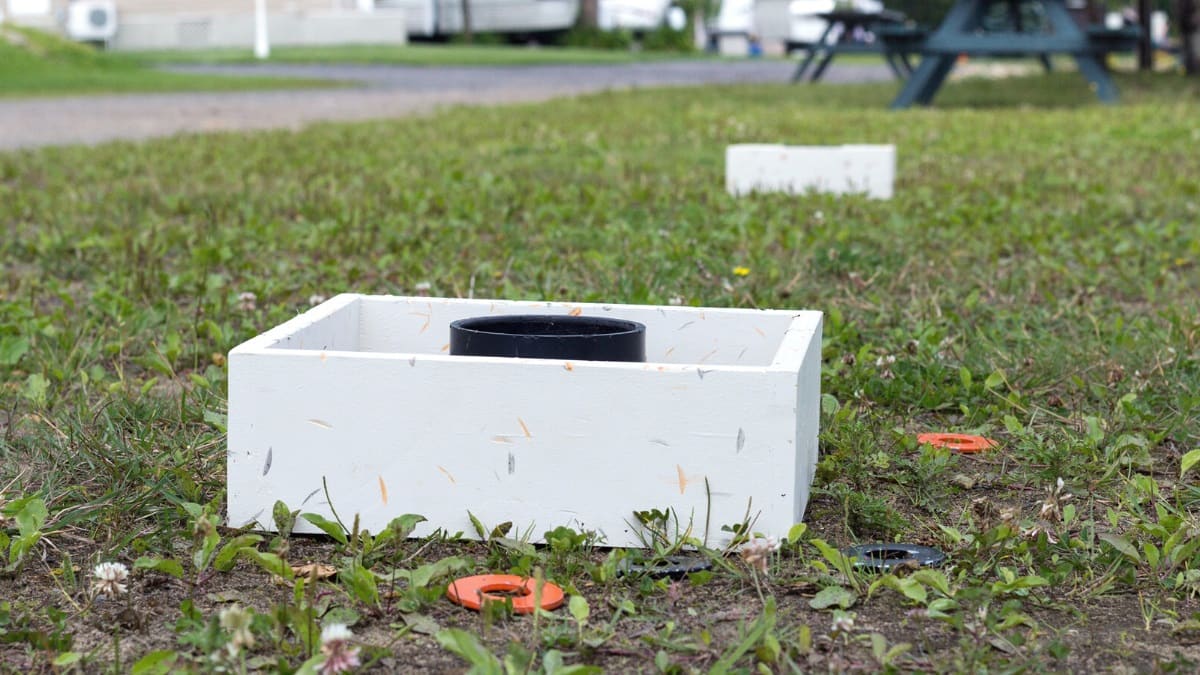I may earn a small commission from purchases made through product links on this website at no extra cost to you. As an Amazon Associate I earn from qualifying purchases.
Last updated: March 15, 2024
Learn how to play the washer toss game with these simple rules, including dimensions and distance, how to keep score, and insider tips.
Simple in its rules yet demanding in its accuracy, washer toss is no mere pastime. It’s a contest of finesse, a duel of aim. But don’t be fooled. Though the tools of the game might fit in your pocket, the thrill of landing that perfect toss is bigger than life itself. Ready to dive in?
In this article, I will explain what washer toss is, how the rules work, how to set up the field with the correct dimensions, and some alternative and advanced options.
What Is Washer Toss?
Washer toss, also known as washer pitching, tailgate toss, washers, or sewers, is similar to cornhole or horseshoes in that you’re tossing an object with the aim of getting it as close to a set target as possible.
It’s a simple game that is easy to learn for everyone, which makes it that much more fun to play for all ages and fitness levels.
The concept is very basic: throw a small round object (washer) into a square-shaped box to earn a point. Bonus points if the washer ends up in a small cup in the middle of the box.
The origin of washer toss is a bit of a mystery, although you might find various stories online diving into where the washer toss game may have been first invented.
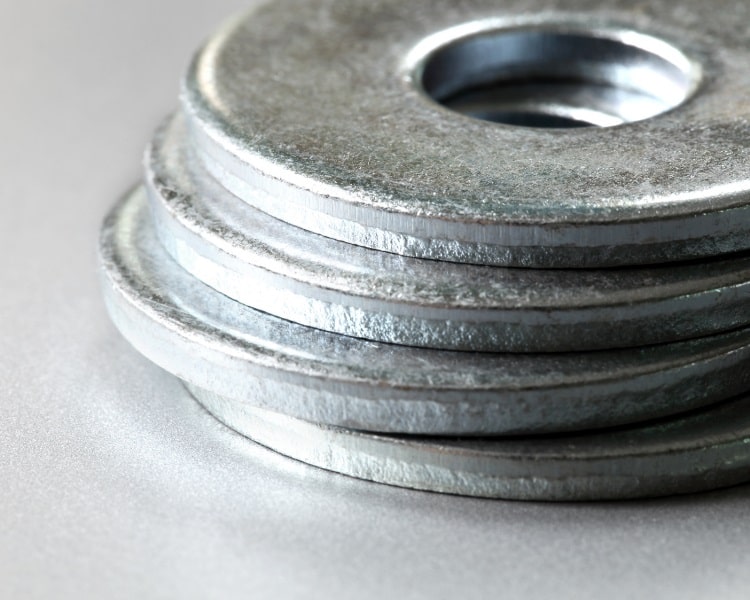
The game is called washer toss or washers because the game revolves around throwing actual washers. A washer is a thin plate with a hole in the middle that can be used in various ways.
Why do I like this game?
At its core, the game is super basic, and anyone can learn how to play. But as you play this game more often, you will notice that some skill is required to get better at it.
When you can get a few mates together to play regularly, washer toss becomes more than just a fun pastime. As you play more often, your skills will improve, and a healthy dose of competitiveness becomes a part of the game.
- OFFICIAL SIZE! The set includes two 12in x 12in targets that set up in minutes...
- INCLUDES (6) steel core washers with built in bottle openers. (3 red and 3 blue)
- COLLAPSIBLE "fold and go" design makes this a fun, portable game you can play...
Washer Toss Rules for Dummies
To explain how the game and rules of washer toss work, I am going to walk you through the following topics:
- Equipment
- Dimensions, distance and setup
- Game objective
- Game rules
- Keeping score
- Game terminology
- Game etiquette
Let’s first have a look at the equipment you will need.
1. Equipment
There are two crucial equipment elements in the game of washer toss:
- Target boxes
- Washers
First, you will need two target boxes. These are usually plastic or wooden boxes, measuring about 14×14 or 16×16 inches. In the middle of the box is an open cup or section of a pipe that is about 4 inches wide.
Second, you will need washers. These are round, thin disks with a hole in the middle, usually made of metal or plastic. Typically, these are about 2-2.5 inches in diameter. You will need eight of these (preferably 4 in each color), although some sets come with only six washers.
Washer toss game sets are easy enough to make, or you can buy one relatively cheaply online, which is what I always do.
2. Dimensions, Distance and Setup
You can play washer toss with two players (1 vs 1) or four players (2 vs 2).
Place the target boxes on a flat and open space, 20 feet apart (though you can shorten or lengthen this based on players’ abilities).
2-Player game:
Players stand on either side of the target box and throw their washers in the same direction. Rotate sides after each round.
4-Player game:
Players from opposing teams stand on either side of the target box, with teammates standing across from each other.
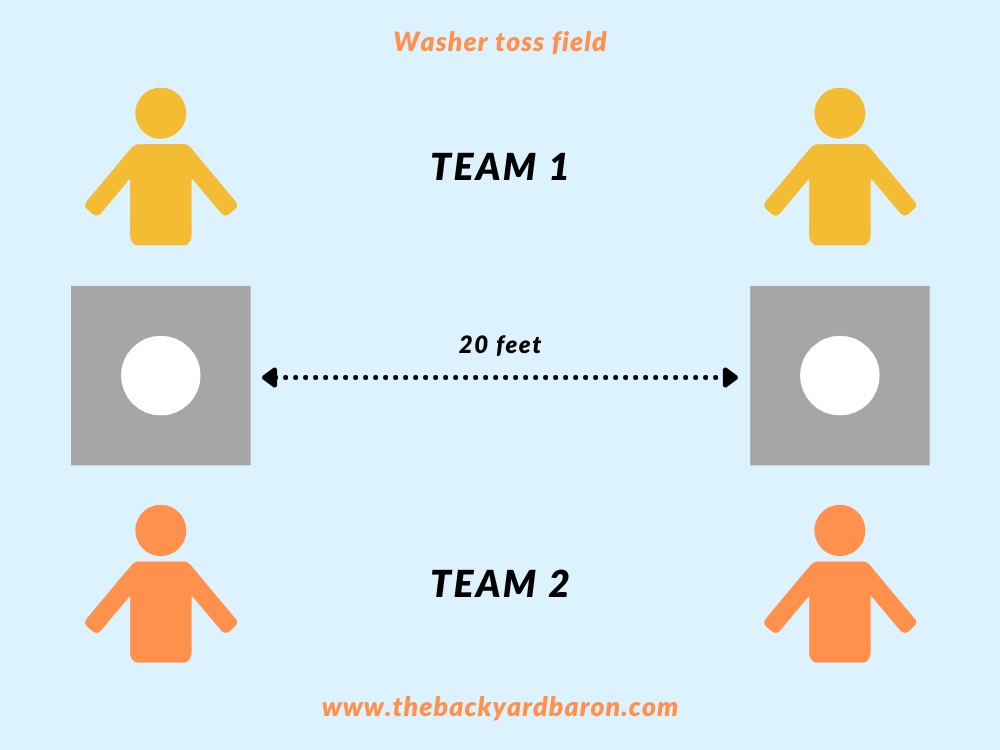
3. Game Objective
You may have already guessed this, but the objective of the game is to score more points than the other team.
A team or player scores points by successfully throwing their washers into the target box. Whoever scores 21 or more points first, wins.
Who goes first?
This is decided by a “diddle”, where each player throws a washer toward the target box. Whoever has the closest washer to the central cup goes first.
A second diddle happens if there is a tie in the first round.
4. Game Rules
These are the basic rules of washer toss:
- Each player, or team, alternates turns until all eight washers have been thrown.
- Players can toss from either side of the target box (towards the opposite target box) and are allowed to have one foot in front of the box.
- A washer can bounce into the box and still earn points.
- If a washer is thrown and balances on the edge of the box, that player wins the game.
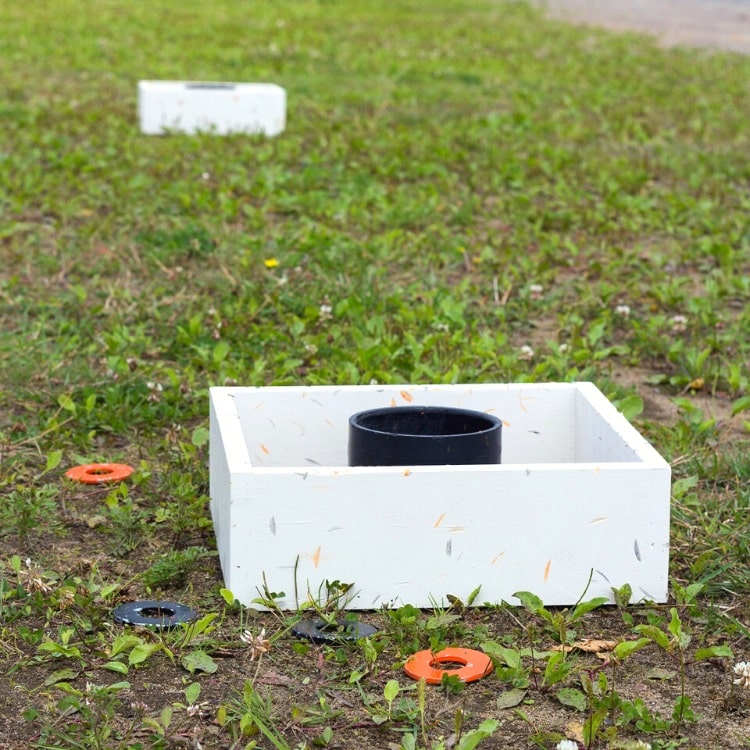
There are also a few more advanced rules to make the game a bit more technical and exciting:
Exacta rule:
A player, or team, has to get exactly 21 points to win, and if they go over, they go back to 15 points and work their way up again.
Skunk rule:
If a player, or team, scores 11 points before the other team scores any points, they win the game.
Whitewash rule:
If a player or team scores 17 points and the other team has scored only 1 point, the team with 17 points wins the game.
5. Keeping Score
The washer toss scoring system is as follows:
- 3 Points for a washer thrown into the center cup or pipe.
- 1 Point for a washer that lands in the target box.
- 0 Points for anything outside the box.
Cancellation Scoring
The concept of cancellation scoring applies to washer toss, which means that only 1 team can score points per round.
Each point that Team A scores takes away from Team B’s score. The scores cancel each other out, and the winner of the round earns the difference between the two scores.
Example:
Team A:
1 washer in the box (1 point).
1 washer in the cup (3 points).
1 washer outside the box (0 points).
-> Team A has scored 4 points.
Team B:
3 washers in the box (3 points).
-> Team B has scored 3 points.
Team B’s 3 points cancel out 3 points from Team A.
As a result, Team A has 1 point, and Team B has 0 points.
6. Game Terminology
You already know what the washers, the target boxes, and the central cup are, but you might hear some more funky terms.
- Washer Pit:
This is simply another term for the entire target box with the cup or pipe in the middle. - Cupper:
This is your 3-pointer; when a washer lands inside the cup or pipe. - On The Fly:
If it lands straight in the middle cup without hitting anything else. - Hanger:
You may never witness this! A hanger is when a washer lands on the rim of the cup or pipe (not the box). - Hammer:
When one team’s washer lands on top of the opponent’s washer inside the cup or pipe.
7. Game Etiquette
Playing washer toss is always more fun when teams agree on rules and play together nicely. Here are some tips to keep play friendly:
- Players agree not to distract their opponent.
- Whichever team scores the points in the previous round, goes first in the next round.
- If washers are too similar a distance to determine a winner during the diddle, either use a measuring tape or toss again.
When you’re throwing, throw underhand for the best accuracy. Some players like to curl their index finger around the disc, similar to when you skip a rock.
Find a good stance that works for you. You can put one foot beyond the box, which might help with the trajectory, or anchor in place with your feet hip-width apart. Take note of when a throw works, and repeat that stance and motion.
Conclusion
Washer toss is a fantastic pastime for all ages and fitness levels, the perfect game to play in the backyard with friends and family.
While the washer toss game rules outlined above are the most commonly accepted ones, you can change them up to make them work for you.
For example, you could move the boxes closer or further away, or don’t use cancellation scoring, just to give you some examples of flexibility.
Happy tossing!
